Research Article
Volume 2 Issue 2 - 2018
An Exploratory Double-Blind Randomized Control Trial Investigating the Effects of Core Activated Hamstring Stretching
Assistant Professor, Physical Therapy Department, Wheeling Jesuit University, USA
*Corresponding Author: David Edwards, PT, DPT, OCS, Cert. DN, Assistant Professor, Physical Therapy Department, Wheeling Jesuit University, USA.
Received: May 13, 2018; Published: May 21, 2018
Abstract
Objectives: To assess the effectiveness of improving toe-touch performance and sit and reach performance using core-activated hamstring stretching.
Methods: The subjects in this double-blind randomized control trial were forty-five 18-35 year old adults. The control group completed static hamstring stretching and the treatment group completed core-activated stretching.
Results: Both groups significantly improved both functional movement patterns from pre to post stretch. The traditional stretch group demonstrated a statistically significant improvement in both toe-touch as well as sit and reach performance with a p-value of .000. The core-activated group also demonstrated a statistically significant improvement in both movement patterns with a p-value of .000. There was no significant difference between the two groups (p = .471 and p = .826).
Conclusion: Although core-activated stretching was not shown to be more effective than static traditional stretching, it gives a physical therapist another option for improving functional mobility as it was shown to be effective overall. Identification of patients who will benefit from core-activated hamstring stretching is proposed to be important for initial mobility exercise choice, but the technique can be used when traditional stretching fails.
Keywords: Core-activated hamstring stretching; Traditional-hamstring stretching; Long-sit test; Toe-touch performance; Functional mobility
Introduction
Muscular flexibility is an important component of general wellness. Limitations in muscular flexibility can create various complications including overuse injuries, impaired posture, can promote poor body mechanics, and creates inefficient body movements [1-12]. This study aimed to evaluate individual’s hamstring flexibility in comparison with two different types of therapeutic interventions. The primary function of the hamstring group is to provide knee flexion and hip extension, which we know are both important movements for activities of daily living and athletic performance.
Poor toe touch performance and or sit and reach movement can drastically affect daily function and potentially lead to improper compensatory patterns of movement. Proper and efficient toe touch movement is needed for activities such as fielding a ground ball, lifting a box from the floor or simply putting on one’s socks. Again, if this movement is lacking motion or is inefficient, it can have negative effects on proper body mechanics and lead to damaging compensatory patterns of movement [1, 4-6].
This study aimed to compare the effect of core activated hamstring stretching to traditional hamstring stretching assessing acute change in toe touch as well as sit and reach performance. Many patients report tight hamstrings with poor toe touch performance, but do not respond to traditional forms of hamstring stretching, thus further need for alternative intervention is warranted [13-16]. Traditional hamstring stretching relies on principles or theories of direct tissue lengthening. Core activated hamstring stretching combines core activation with active stretching, which may improve toe touch performance by theoretically facilitating proper core activation pattern during movement and/or decreasing neural tone.
Previous research has shown that static stretching demonstrates statistically significant increases in hamstring flexibility over extended treatment duration [2,7,17]. The goal of this study was to determine the effectiveness of core-activated hamstring stretching compared to static stretching. A previous study examining the immediate effects of passive and active stretching found significant improvement compared to pre-intervention measurement, however active stretching showed improvement to a lesser extent potentially due to postural compensatory movements6. By implementing core activation, it may be possible to provide a home therapy intervention equally as effective as implemented by a therapist. It was hypothesized that subjects would show a greater mean change in acute toe touch as well as long sit and reach performance post core activated hamstring stretching versus the traditional hamstring stretching.
Methods
Methodology
Sample selection occurred through sample of convenience at Midwest University and IRB approval was obtained prior to starting the study. Each participant signed an informed consent form and was randomly placed into a traditional or core-activated stretch group. This was done through random draw out of a hat when the participant walked into the testing area.
Sample selection occurred through sample of convenience at Midwest University and IRB approval was obtained prior to starting the study. Each participant signed an informed consent form and was randomly placed into a traditional or core-activated stretch group. This was done through random draw out of a hat when the participant walked into the testing area.
The subject’s sit and reach test measurement and toe touch measurement was then taken by one of the researchers (see testing description below). The subject was then taken through either a traditional hamstring stretch protocol or a core-activated stretch protocol (see below) by two different researchers. The original testing researcher then took posttest measurements for sit and reach distance and toe touch distance and was unaware of the particular stretching protocol used with the subject. The measures were recorded in Excel.
Subjects
Subjects in this study included forty-five volunteer students from Wheeling Jesuit University’s Physical Therapy program, and volunteers from Anytime Fitness, St. Clairsville, Ohio. To be included, subjects were required to be within the age range of 18-35 years old. Subjects were excluded on the condition that they had previous lower extremity, spinal, musculoskeletal, neuromuscular or cardiovascular pathologies within the past 6 months. Subjects were also excluded if they had exercised within 2 hours of receiving the treatment.
Subjects in this study included forty-five volunteer students from Wheeling Jesuit University’s Physical Therapy program, and volunteers from Anytime Fitness, St. Clairsville, Ohio. To be included, subjects were required to be within the age range of 18-35 years old. Subjects were excluded on the condition that they had previous lower extremity, spinal, musculoskeletal, neuromuscular or cardiovascular pathologies within the past 6 months. Subjects were also excluded if they had exercised within 2 hours of receiving the treatment.
Sit and Reach Test
Subjects sit and reach scores were measured immediately before interventions to establish their baseline, and post-treatment measurements were completed immediately after treatment. Both measurements utilized a Baseline Sit and Reach test box. Subjects were positioned on the floor in a long sit position, with their shoes removed, and the subject was then instructed on measurement procedures.
Subjects sit and reach scores were measured immediately before interventions to establish their baseline, and post-treatment measurements were completed immediately after treatment. Both measurements utilized a Baseline Sit and Reach test box. Subjects were positioned on the floor in a long sit position, with their shoes removed, and the subject was then instructed on measurement procedures.
Subjects were instructed to lock their knees in 0 degrees of extension pressed against the floor, overlap hands, and to reach forward along the measurement line on top of the box as far as tolerable in a slow, controlled motion while moving the sliding pin on top of the box. Subjects were instructed to hold the position for 2 seconds allowing for measurements to be recorded.
Both measurements required the subject to close their eyes. Asking the subjects to close their eyes was necessary to prevent them tolerating a more painful stretch during the after treatment measurements because improvement is assumed by the subject.
Toe Touch Test
Subjects Toe Touch scores were measured immediately before interventions to establish their baseline, and post-treatment measurements were completed immediately after treatment. Both measurements utilized a Toe Touch test. Subjects stood with their feet together and fingers interlocked in front of their body. They were asked to lean forward and touch the floor with their interlocked fingers without bending their knees and told to hold the position for 2 seconds. In order to measure the distance, the surveyor used measuring tape to measure the distance from the floor to the tips of subject’s fingers in centimeters. If the subjects could touch the floor before the stretch, they were placed standing on an elevated box to allow room for further gain in motion.
Subjects Toe Touch scores were measured immediately before interventions to establish their baseline, and post-treatment measurements were completed immediately after treatment. Both measurements utilized a Toe Touch test. Subjects stood with their feet together and fingers interlocked in front of their body. They were asked to lean forward and touch the floor with their interlocked fingers without bending their knees and told to hold the position for 2 seconds. In order to measure the distance, the surveyor used measuring tape to measure the distance from the floor to the tips of subject’s fingers in centimeters. If the subjects could touch the floor before the stretch, they were placed standing on an elevated box to allow room for further gain in motion.
Intervention Methodology
Interventions were performed under researcher supervision. Subjects were randomly assigned to 2 groups, core activated group, and control traditional stretching group. For the core-activated group, subjects were instructed on how to perform two exercises. The first exercise (see image 1), the subject was instructed to stand with feet together and to make a triangle with their thumb and forefinger of each hand and place their hands on an exercise ball placed in front of them. The subject was then asked to brace their abdominals, and press into the exercise ball with their upper extremities, and bring their nose towards the exercise ball to perform the stretch. Subjects bent their elbows as they brought their nose to their hands. This exercise was performed for 3 sets of 10 repetitions with a two second hold at the bottom of the stretch.
Interventions were performed under researcher supervision. Subjects were randomly assigned to 2 groups, core activated group, and control traditional stretching group. For the core-activated group, subjects were instructed on how to perform two exercises. The first exercise (see image 1), the subject was instructed to stand with feet together and to make a triangle with their thumb and forefinger of each hand and place their hands on an exercise ball placed in front of them. The subject was then asked to brace their abdominals, and press into the exercise ball with their upper extremities, and bring their nose towards the exercise ball to perform the stretch. Subjects bent their elbows as they brought their nose to their hands. This exercise was performed for 3 sets of 10 repetitions with a two second hold at the bottom of the stretch.
In the second exercise (see image 2), subjects were positioned supine. Patients were instructed to perform alternating straight leg raises, while extending bilateral upper extremities against resistance band pressure, subjects were instructed to brace their core musculature throughout the leg movement. Subjects performed 3 sets of 10 repetitions for each leg.
For the traditional stretching group, subjects were instructed in two exercises. In the first exercise, subjects stood with their feet together and were instructed to flex at their hips, bringing their hands as close to the floor as they can tolerate, and hold. Subjects were prompted to maintain 0 degrees of knee extension during the stretch. Subjects were instructed to hold for the stretch for 30 seconds and repeat for 3 repetitions (see image 3).
The second exercise, subjects were positioned in a supine position. Subjects were instructed to put an exercise stretch band under the plantar surface of the foot, and to maintain 0 degrees of knee extension while flexing their hip to the farthest tolerable position to apply a static stretch (see image 4). Exercise was performed unilaterally, holding the position for 30 seconds, for 3 repetitions on each limb.
Statistical Analysis
Subject data was analyzed using both dependent and independent t-tests to compare pre and post intervention measurements in both the experimental and control groups. Dependent t-tests were performed to compare sit and reach distance as well as toe-touch performance before and after stretch intervention in both groups. An independent t-test was run to compare the core-activated versus the traditional stretch groups for both sit and reach distance and toe-touch performance. The significance level was established as p ↓ 0.05 prior to performing the experiment. Data analysis was performed using IBM SPSS Statistics 20 (IBM Corporation, Armonk, New York).
Subject data was analyzed using both dependent and independent t-tests to compare pre and post intervention measurements in both the experimental and control groups. Dependent t-tests were performed to compare sit and reach distance as well as toe-touch performance before and after stretch intervention in both groups. An independent t-test was run to compare the core-activated versus the traditional stretch groups for both sit and reach distance and toe-touch performance. The significance level was established as p ↓ 0.05 prior to performing the experiment. Data analysis was performed using IBM SPSS Statistics 20 (IBM Corporation, Armonk, New York).
Results
Utilizing dependent and independent t-tests using SPSS for Windows, it was found that both sit and reach distance and toe-touch performance and improved significantly in both the traditional stretch group and the core-activated stretch group (p < 0.05). However, there was no significant difference in test performance between the two intervention groups (p ≥ 0.05) and the static strength group improved slightly more.
Traditional Stretching Hamstring Group - Toe Touch Test
The mean for the pre-stretch toe-touch test was 22.9826 cm (SD = 11.13000) for the subjects (N = 23). The mean for the post-stretch toe touch test was 20.1652 cm (SD = 10.81697) for the subjects (N = 23), which is a mean change of 2.81 cm. The difference of the means was statistically significant (p = 0.00) See Table 1.
The mean for the pre-stretch toe-touch test was 22.9826 cm (SD = 11.13000) for the subjects (N = 23). The mean for the post-stretch toe touch test was 20.1652 cm (SD = 10.81697) for the subjects (N = 23), which is a mean change of 2.81 cm. The difference of the means was statistically significant (p = 0.00) See Table 1.
Traditional Stretching Hamstring Group - Long Sit and Reach Test
The mean for the pre-stretch long sit test was 25.7478 cm (SD = 25.7478) for the subjects (N = 23). The mean for the post-stretch long sit test was 28.2174 cm (SD = 1.87905) for the subjects (N = 23), which is a mean change of 2.46 cm. This difference of the means was statistically significant (p = 0.00). See Table 2.
The mean for the pre-stretch long sit test was 25.7478 cm (SD = 25.7478) for the subjects (N = 23). The mean for the post-stretch long sit test was 28.2174 cm (SD = 1.87905) for the subjects (N = 23), which is a mean change of 2.46 cm. This difference of the means was statistically significant (p = 0.00). See Table 2.
Core Activated Hamstring Group - Toe Touch Test
The mean for the pre-stretch toe touch test was 16.3318 cm (SD = 9.03266) for the subjects (N = 22). The mean for the post-stretch toe touch test was 13.6318 cm (SD = 8.55411) for the subjects (N = 22), which was a mean change of 2.7 cm. The difference of the means was statistically significant (p = 0.00). See Table 3.
The mean for the pre-stretch toe touch test was 16.3318 cm (SD = 9.03266) for the subjects (N = 22). The mean for the post-stretch toe touch test was 13.6318 cm (SD = 8.55411) for the subjects (N = 22), which was a mean change of 2.7 cm. The difference of the means was statistically significant (p = 0.00). See Table 3.
Core Activated Hamstring Group - Long Sit and Reach Test
The mean for the pre-stretch long sit test was 32.4409 cm (SD = 7.99164) for the subjects (N = 22). The mean for the post-stretch long sit test was 34.5227 cm (SD = 7.72756) for the subjects (N = 22), which was a mean change of 2.08 cm. This difference of the means was significantly significant (p = 0.00). See Table 4.
The mean for the pre-stretch long sit test was 32.4409 cm (SD = 7.99164) for the subjects (N = 22). The mean for the post-stretch long sit test was 34.5227 cm (SD = 7.72756) for the subjects (N = 22), which was a mean change of 2.08 cm. This difference of the means was significantly significant (p = 0.00). See Table 4.
Traditional Stretch Group vs. Core Activated Hamstring Group - Toe Touch Test
The mean increase in the traditional stretch group for the toe touch test was 2.8174 cm (SD = 2.50720) for the subjects (N = 23) while the mean increase in the core activated hamstring group for the toe touch test was 2.7000 cm (SD = 2.57774) for the subjects (N = 22). This difference of the means was found not to be statistically significant (p=0.826). See Table 5.
The mean increase in the traditional stretch group for the toe touch test was 2.8174 cm (SD = 2.50720) for the subjects (N = 23) while the mean increase in the core activated hamstring group for the toe touch test was 2.7000 cm (SD = 2.57774) for the subjects (N = 22). This difference of the means was found not to be statistically significant (p=0.826). See Table 5.
Traditional Stretch Group vs. Core Activated Hamstring Group - Long Sit and Reach Test
The mean increase in the traditional stretch group for the toe touch test was 2.4696 cm (SD = 2.24751) for the subjects (N = 23) while the mean increase in the core activated hamstring group for the toe touch test was 2.0818 cm (SD = 2.06251) for the subjects (N = 22). This difference of the means was found not to be statistically significant (p = 0.471). See Table 6.
The mean increase in the traditional stretch group for the toe touch test was 2.4696 cm (SD = 2.24751) for the subjects (N = 23) while the mean increase in the core activated hamstring group for the toe touch test was 2.0818 cm (SD = 2.06251) for the subjects (N = 22). This difference of the means was found not to be statistically significant (p = 0.471). See Table 6.
Discussion
Stretching has long been the gold standard for increasing tissue length, and has proven its efficacy time and time again. The intent of this study was to test a non-traditional method with the hope that it would produce increased results. The results have shown that core activated hamstring stretching produces a significant increase in functional movement. While this increase is not significantly greater than traditional stretching, it is yet another tool those therapists may use to promote acute gains in flexibility.
It is likely that patients with faulty core activation patterns the ones who benefit the most form this stretching modality. It is often the case that one particular form of an intervention does not improve patient’s impairments, but with a different intervention the patient improves. This is the case with manual techniques, soft tissue techniques and exercise. Again, core-activated hamstring stretching was shown to be effective and offers another option for gaining functional mobility.
Through activation of the core musculature with this intervention, the patient is stretching in a core-activated movement pattern. Stretching while operating on a stable and facilitated core may improve stretch depth per a more optimal movement pattern. Benefit may cross over to individual’s everyday life through prolonged exposure, promoting core engagement and proper posturing.
This study warrants further progression to monitor the later effects of continued core activated hamstring stretching. As only acute measurements were taken, increased benefit may be derived from a prolonged treatment schedule. Due to the nature of this study, these chronic effects or repeated intervention were not tested. One limitation in the study is that all of the subjects were healthy and pain-free. It is unknown whether the same effects would occur if the techniques were done with patients recovering from, for example, a hamstring injury or a bout of low back pain.
Conclusion
While it was found that both traditional stretching techniques and core activated hamstring stretching produced significant increases in both toe touch and sit and reach hamstring extensibility, neither technique was found to be statistically more effective than the other. The results of this study have showed continued evidence that static stretching is an effective resource for increasing tissue extensibility acutely. Additionally, it has been confirmed that through core activation techniques, clinically significant results may be achieved pre to post stretch, but not better than static stretching.
Identification of appropriate patients is proposed to be important when utilizing core-activated stretching at this first mobility exercise selected. It is likely that patients with faulty core activation patterns will benefit most from this technique, while patients with pure muscle length flexibility deficits will benefit from static stretching or other forms of mobility exercise. Further investigation into patient selection for the technique and long term effects of the stretching technique are warranted.
References
- Ahmed H., et al. “Effect of modified hold-relax stretching and static stretching on hamstring muscle flexibility”. Journal of Physical Therapy Science 27.2 (2015): 535-538.
- Castellote-Caballero Y., et al. “Effects of a neurodynamic sliding technique on hamstring flexibility in healthy male soccer players. A pilot study”. Physical Therapy in Sport 14.3 (2013): 156-162.
- Davis D., et al. “The effectiveness of 3 stretching techniques on hamstring flexibility using consistent stretching parameters”. Journal of Strength and Conditioning Research 19.1 (2005): 27-32.
- Decoster L. “Effects of hamstring stretching on range of motion”. Athletic Training & Sports Health Care 1.5 (2009): 209-213.
- Hartig D and Henderson J. “Increasing Hamstring Flexibility Decreases Lower Extremity Overuse Injuries in Military Basic Trainees”. American Journal of Sports Medicine 27.2 (1999): 173-176.
- Khalili MA and Bakhtiary AH. “Two methods for improvement of short hamstrings in healthy individuals”. Middle East Journal of Rehabilitation and Health 1.2 (2014).
- Magalhaes F., et al. “Comparison of the effects of hamstring stretching using proprioceptive neuromuscular facilitation with prior application of cryotherapy or ultrasound therapy”. Journal of Physical Therapy Science 27.5 (2015): 1549-1553.
- Nagarwal AK., et al. “Improvement of hamstring flexibility: A comparison between two PNF stretching techniques”. International Journal of Sports Science and Engineering 4.1 (2010): 25–33.
- Nishikawa Y., et al. “Immediate effect of passive and active stretching on hamstrings flexibility; a single-blinded randomized control”. Journal of Physical Therapy Science 27.10 (2015): 3167-3170.
- Puentedura E., et al. “Immediate effects of quantified hamstring stretching: Hold-relax proprioceptive neuromuscular facilitation versus static stretching”. Physical Therapy in Sports 12.3 (2011): 122-126.
- Rani B and Mohanty PP. “A comparison between two active stretching techniques on hamstring flexibility in asymptomatic individuals”. IOSR Journal of Dental and Medical Sciences 14.4 (2015):12–16.
- Shankar G and Yogita. “Effectiveness of passive stretching versus hold relax technique in flexibility of hamstring muscle”. Online Journal of Health Allied Sciences 9.3 (2010):13.
- Askling C., et al. “Hamstring injury occurrence in elite soccer players after preseason strength training with eccentric overload”. Scandinavian Journal of Medicine and Science in Sports 13.4 (2003): 244-250.
- Ben M and Harvey L. “Regular stretch does not increase muscle extensibility: a randomized controlled trial”. Scandinavian Journal of Medicine & Science in Sports 20.1 (2010):136-144.
- Castellote-Caballero Y., et al. “Immediate effects of neurodynamic sliding versus muscle stretching on hamstring flexibility in subjects with short hamstring syndrome”. Journal of Sports Medicine 2014 (2014):1–8.
- Provance S., et al. “Effect of stretch duration on hamstring flexibility”. Missouri Journal of Health, Physical Education, Recreation & Dance16 (2006): 21-26.
- Chen C., et al. “Two stretching treatments for the hamstrings: proprioceptive neuromuscular facilitation versus kinesio taping”. Journal of Sport Rehabilitation 22.1 (2013): 59-66.
Citation:
David Edwards., et al. “An Exploratory Double-Blind Randomized Control Trial Investigating the Effects of Core Activated
Hamstring Stretching”. Orthopaedic Surgery and Traumatology 2.2 (2018): 302-310.
Copyright: © 2018 David Edwards., et al. This is an open-access article distributed under the terms of the Creative Commons Attribution License, which permits unrestricted use, distribution, and reproduction in any medium, provided the original author and source are credited.



































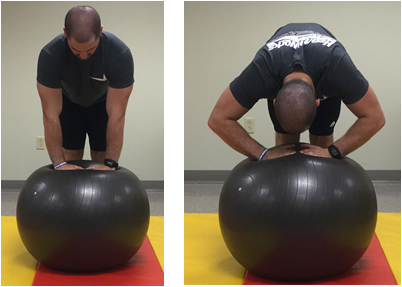
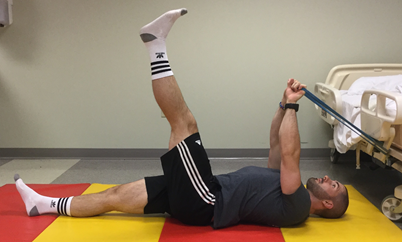
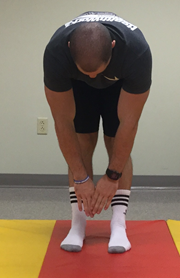
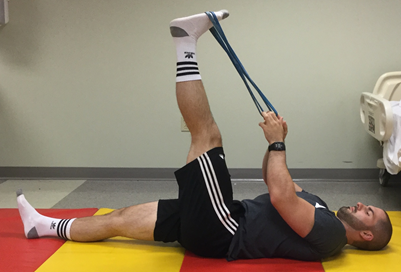
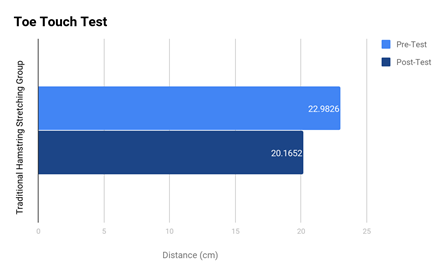
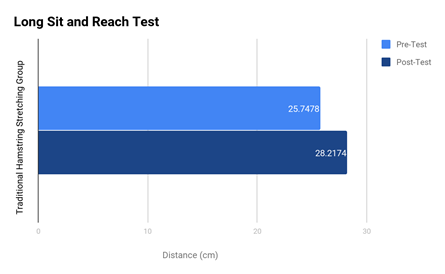
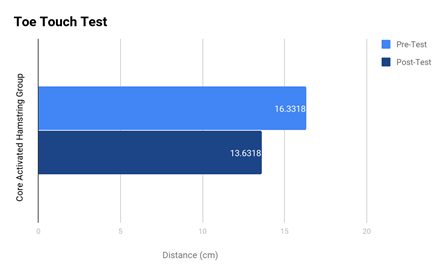
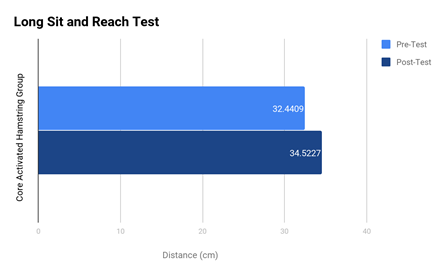
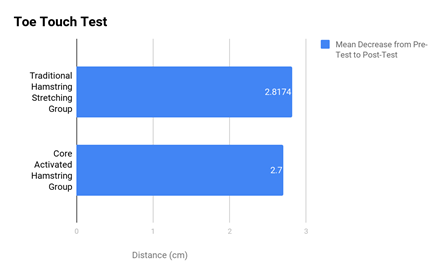
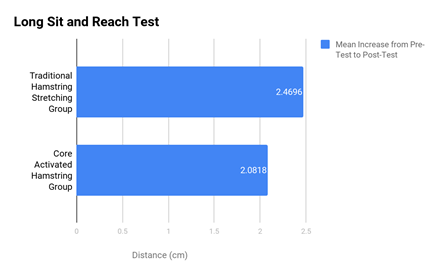
 Scientia Ricerca is licensed and content of this site is available under a Creative Commons Attribution 4.0 International License.
Scientia Ricerca is licensed and content of this site is available under a Creative Commons Attribution 4.0 International License.